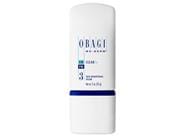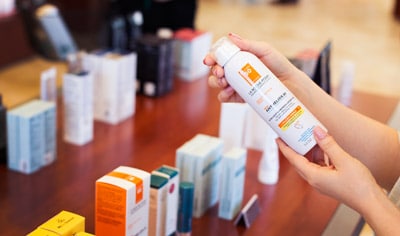
Nearly everyone has a discolored spot or two on their skin, more commonly known as a mole or freckle. In many cases, these spots are harmless, but some can evolve into something more dangerous like skin cancer. While a mole or freckle can look similar in some cases, they are not interchangeable and may change over time. Sometimes, what starts out as a 'freckle' can turn into a mole and then progress to a form of melanoma over time. Knowing the difference between the two, as well as which alarming signs to look for is one of the most important things you can do for skin health. To help determine if a spot is a mole or freckle, we’ll discuss:
- What is a freckle?
- What is a mole?
- Differences between a mole vs. freckle.
- When to see your dermatologist.
What is a Freckle?
Freckles are a cluster of flat, light brown or tan spots that typically show up on areas of the skin that are exposed to the sun or other ultraviolet rays. They are the result of the body’s overproduction of melanin, which is the natural pigment responsible for skin and hair color. Genetics can increase your likelihood of developing freckles, especially if you have red or blonde hair, light skin or skin that doesn’t tan well.
The vast majority of freckles rarely, if ever, develop into skin cancer. There are two different types of freckles: ephelides and solar lentigines.
Ephelides are a common type of freckle that can occur as a result of sun exposure, but are usually attributed to genetics. These types of freckles may fade during winter months when sun exposure is at its lowest, and pop back up during the summer. The mere existence of a freckle may indicate sun exposure caused damage to the skin, which is then noted as a freckle.
Solar lentigines tend to occur later in life, usually after forty, and can look like dark spots on the skin as a result of sunburn or excessive sun exposure. Solar lentigines usually won’t fade during the winter months like ephelides.
What is a Mole?
Moles, or medically referred to as nevi, are a collection of melanocyte cells in the skin. They are usually raised (but not always) and can appear in a wide array of colors, including brown, tan, black, red, pink or even blue. Moles can pop up in groups but typically appear singularly. Like freckles, moles can be attributed to genetics or sun exposure and in most cases are harmless, but do have the ability to become skin cancer.
We checked in with board-certified dermatologist and LovelySkin CEO Dr. Joel Schlessinger to get the facts on moles.
“There are three common categories of moles: congenital, acquired and atypical. Congenital moles are those you were born with and are often round or oval in shape. Acquired moles appear after birth, which are usually a response to sun exposure, have a smooth surface and present in varying shades of brown. Atypical moles, also known as dysplastic moles, are irregular-shaped moles that can be flat, smooth and multi-colored. Most people have a combination of all three of these on their bodies, all of which are best evaluated by a dermatologist if there is any significant change or concern. It is better to be safe than sorry when it comes to problem moles.”
Differences Between a Mole vs. Freckle
Being diligent with your skin health is important. In most cases, determining if that new spot on your skin is a mole vs. freckle is sometimes easier said than done, but here are some ways to evaluate these two concerns.
They feel (and look) different.
Moles and freckles often don’t feel the same when you brush a finger against them. Moles are often raised on the skin’s surface whereas freckles are typically flat. This isn’t always the case, but it’s a good initial indicator. Moles are often much wider than freckles and can appear rough or bumpy. Dark, flat moles can be a more significant concern, though since these are the moles that may turn into melanoma.
They aren’t the same color.
In general, moles are usually darker than freckles. While excessive sun exposure can cause freckles to deepen, a freckle usually doesn’t get as dark as a mole has the potential to. Dr. Schlessinger says,
“Sun protection is important if you want to prevent skin discoloration. Avoid peak sun hours between 10am-4pm, wear protective clothing and a sun hat when outside. Always wear sunscreen with SPF 30, even on cloudy days.”
For a sheer sunscreen that’s ideal for everyday use, try EltaMD UV Clear Broad Spectrum 46-Untinted. It provides advanced sun protection to protect skin, while improving texture and tone with 5% niacinamide and lactic acid, both of which are acne-friendly.
When to See your Dermatologist
Freckles, early in their evolution, may not need treatment from a dermatologist. They have no medical need to be removed unless they show signs of change, flake or bleed, but if they become unsightly, there are professional cosmetic treatments you can try, including peels or topical lightening creams like Obagi Nu-Derm Clear Fx.
If you have a family history of skin cancer, have more than 25 to 100 moles or have a history of tanning bed use, it’s probably a good idea to have your skin checked by a dermatologist annually. If you see a new mole pop up after age 30, have it checked by a dermatologist, as 75% of melanoma cases happen in these new moles. While freckles have the ability to come and go depending on the time of year, most moles don’t. If you have a spot that is changing in color or shape quickly (over the course of weeks or months), it’s recommended to have it evaluated by a dermatologist.
Also, if a mole doesn’t look like your other moles, it’s best to have it looked at by a professional. While there are many types of skin cancer, the most dangerous of those is melanoma. If you’re unsure of what one looks like, follow the ABCDE rules of melanomas:
- A: Asymmetry
- B: Borders with irregular edges
- C: Color is varied from one area to another
- D: Diameter is larger than a pencil eraser
- E: Evolving over time, changing in size, shape or color
If you have a mole that fits any of those criteria, call your dermatologist ASAP or schedule an appointment today. To find out how to prevent types of hyperpigmentation, like freckles and dark spots, read more on our blog.
Shop this blog

About the Author
Jill is a content writer for LovelySkin. She loves reading up on the latest beauty trends, going to concerts with her husband and baking with her three kids.
Other Posts by JillBoost Firmness and Radiance With SkinCeu...
10 Essentials for Your Beginner’s Makeup...
Follow us on social
Follow us on social networks and be one of the first to learn about sales, giveaways, and free samples









